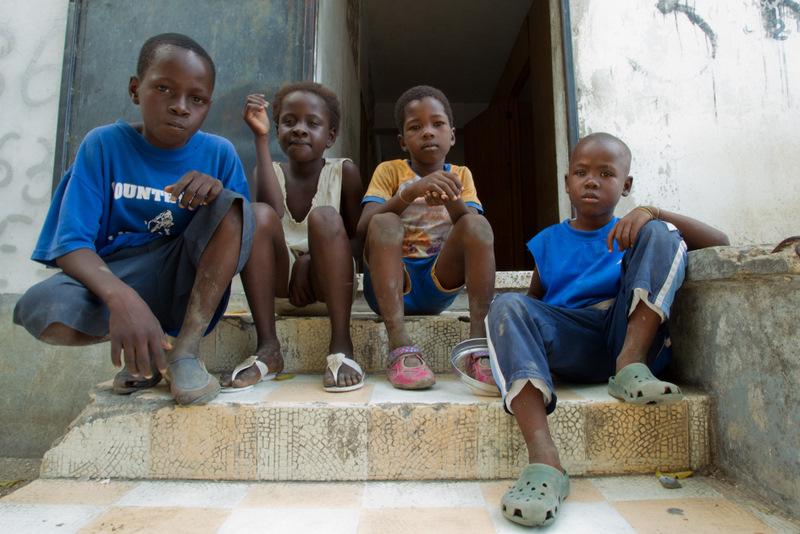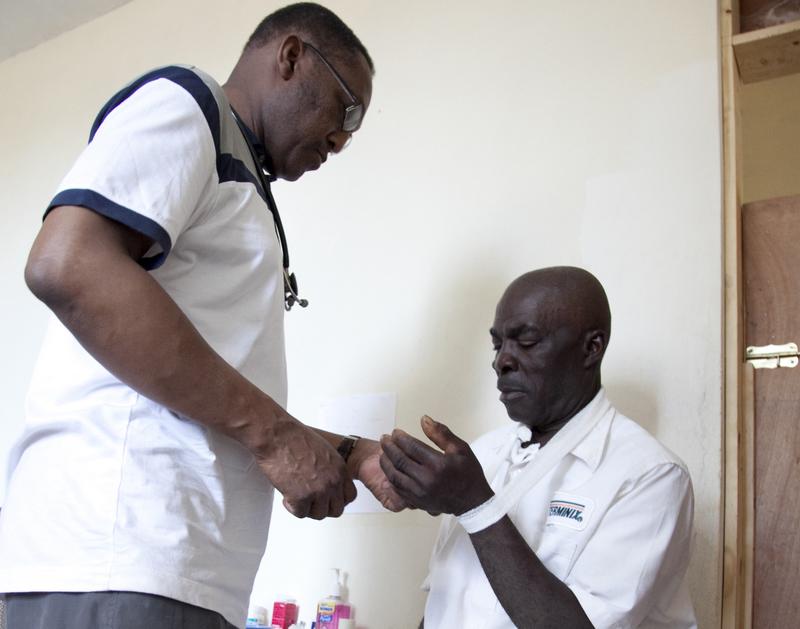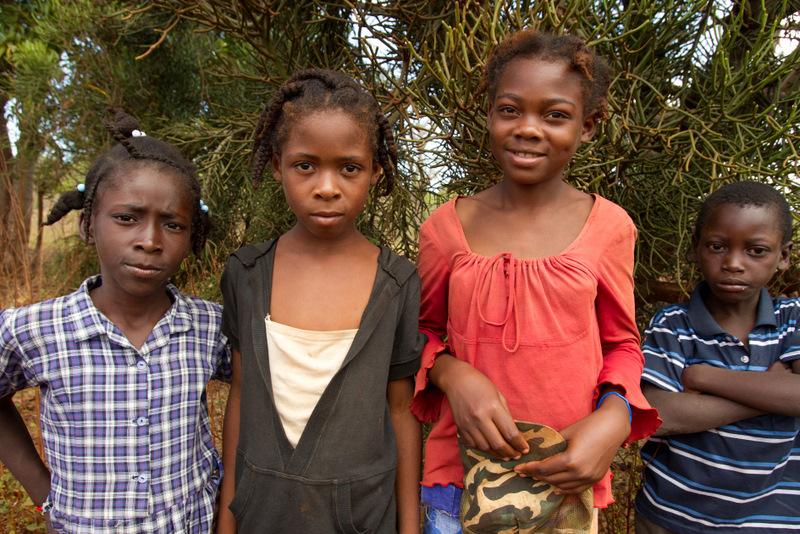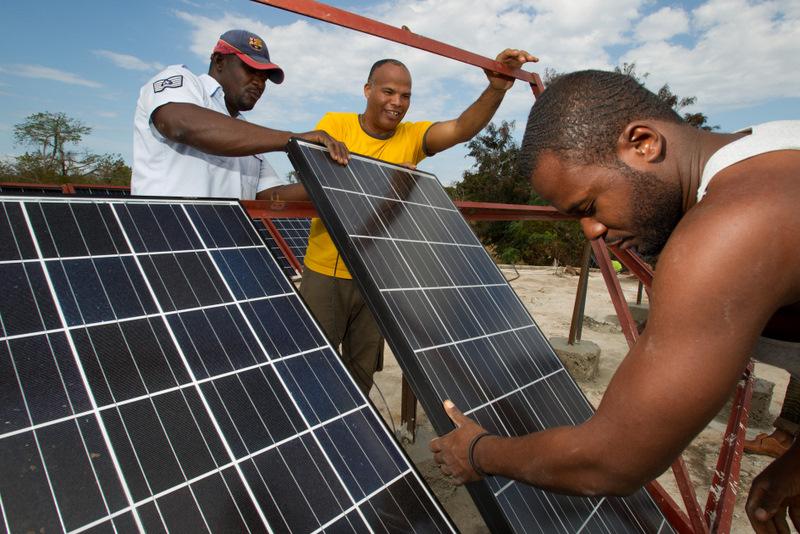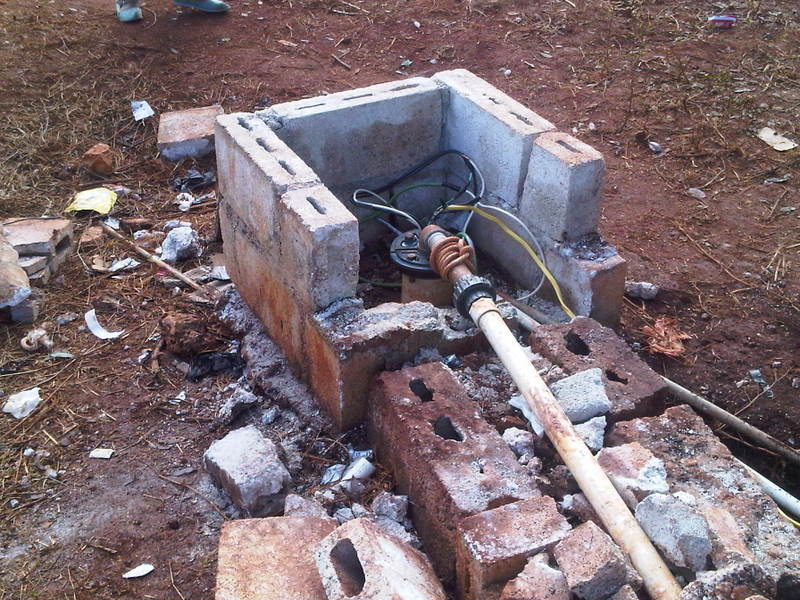Northport Rotary in Nan Sema, Haiti
February 24, 2011
THE ROAD TO
The battered, dusty tires on the pickup truck tell the story. The coral bedrock pokes through the thin layer of dirt on the road from Anse a Galet on the coast to Nan Sema in the center highlands of the La Gonave Island in
That was the destination of a team of Long Island New York Rotarians (District 7260 & 7250) and members of the Mattituck Presbyterian Church, including medical and solar specialists, supported by Haitian Rotarians and local leaders, to install a solar array, new water pump and related wiring. Following the February 14-17, 2011 visit, this small community had a self-sustaining source of water and 24-hour electricity, a rarity in
This trip was part of a longer story of successful community and economic development which had its beginings in 1986. In 1991, two Haitians Jonas Jean Louis and Suplice Edouard, were traveling by motorcycle in central La Gonave. The purpose of their trip was to spread the word of God in the area. Their motorcycle broke down and they approached the closest house. During their conversation with a woman named Enella who owns the house, they inquired of what was most needed in this community of subsistence farmers. She said: “A place to pray.” That began a process of community development with outside assistance that was, and continues to be, based on local priorities. This encounter led to the building of a church, near the spot where the visitors broke down, with resources provided by the Mattituck Presbyterian Church on the North Fork of Eastern Long Island in 1999.
Two key elements set this situation apart from the many failed attempts to bring a community out of a rut of poverty to a sustainable position of economic development. First and foremost was the presence of a local visionary. In this case, Jonas Jean-Louis combined his role as Pastor of the new church at Nan Sema with his job as Director of the La Gonave Branch of Unibank, one of
Church construction was followed by many trips to enhance the facilities and to bring needed supplies. In 2006, Suffolk County Rotary clubs (District 7260), aided by a matching grant from The Rotary Foundation of Rotary International, provided funds for the local people to drilled a water well to provide clean water for the community. Previously, adults and children had to carry water from, or lead donkeys to, a distant water source, taking most of the day and yielding often polluted water. With the new well, run by an electric generator and filling a 30,000 gallon cistern, the community had a local clean water source, allowing children to attend school rather than carry water long distances. Originally expected to serve 500 – 1,000, this water source now provides clean water to upwards of 20,000. The charge for water is low (US$0.01 – 0.25) depending on ability to pay, with proceeds used to maintain the well. The importance of ready water access makes it a community magnet, much like new railroads attract growing communities along their lines.
After the church and the water source, the next prior was medical services. A small clinic was built near the church and well. In 2006 when the well was dug the foundation for the new medical clinic was built and the dreams of the people of Nan Sema were starting to become more of a reality. The Mattituck Presbyterian church provided the funds for the local people to build the clinic and in 2009 when the building was complete the Rotary Clubs of Suffolk County, NY went to work again. They wrote another grant to purchase and ship all the medical equipment and supplies necessary to make the building a medical clinic. Dr. Eric Ferdinand the Island's Health Minister hired a Doctor trained in
The February 2011 project built on the prior work by replacing the generator as the primary source of electricity (it remains as a backup) with an 18-panel solar array producing 2,430 kilowatt/hours of power. The array captures the abundant sunlight and stores electricity in 32 car batteries. These then run the well pump until a newly installed sensor indicates that the cistern is full. The water system is now fully automatic, replacing water as it is used. In the past, the high cost of fuel (US$5 per liter) restricted operation of the generator and pump to only two hours a day.
The solar array also provides electricity to the clinic and the church. Because the prior setup only allowed for the generator to run two hours per day, the clinic only had power for that time. Now it has 24 hour electrical service permitting refrigeration of perishable medical supplies (e.g., vaccines) and operation of medical equipment and lighting.
The project provided some significant challenges. The team needed to protect electric wires between the clinic the wellhead, the generator and the cistern by burying them underground. Digging was uncommon in Nan Sema because the solid coral bedrock is so close to the surface. Haitians have, over the years, cut most of the trees for construction, to clear space for agriculture and to make charcoal, one of the few commodities that provides cash. Deforestation has resulted in the loss of much of the existing topsoil, leaving the coral bedrock close to the surface with outcrops everywhere.
The project included replacing the existing alternating current well pump with a more efficient direct current pump compatible with the solar generated electricity. The change required that the old pump be removed. That pump was attached at the bottom of the water line, a rigid 1 ¼” PVC pipe 180’ in length down the well shaft. The team had to pull the water line and pump out of the well shaft in a tall arching motion that was successful but not without breaking the water line pipe.
Typical of projects in this place, the team discovered that they did not have a local source for the right fittings for attaching the new pump to the bottom of the water line. That required a trip down the mountain to the coastal town of
The new pump and a repaired water line were carefully lowered into the well shaft successfully. After final wiring the pump began refilling the cistern driven by the installed solar array. It was critical that the project succeed at that point as the community water supply in the cistern was nearly exhausted.
In addition to the solar and well pump project, the team included a medical sub-group. Three team members saw 130 community patients during the three days on site. This service took a dramatic turn when during the first evening there a 12 year old boy was brought in around midnight, after falling off a donkey on his face, with extensive damage due to the sharp coral. Dr. Jean tried to suture his face back together but was hindered by the extensive damage. He inquired: “Does anyone have any super glue?” Most thought he was joking. But, super glue is commonly used for surgical repairs, including as a military field surgical material in the Vietnam War. It happened that a member of a media team from Rotary International, there to document the trip for Rotarian magazine, had some, leading to something of a medical miracle, given the location and conditions.
Apart from the chance availability of super glue, the team had brought 34 large duffle bags of donated medicine and medical supplies to stock up the clinic, which is staffed by a local nurse 24/7. With help from Airline Ambassadors, a charitable organization established by airline employees, and American Airlines, the team was able to take the extra baggage without transportation cost. At the airport at Port-au-Prince, the team was met by airport staff under the direction of the President of the Port-au-Prince Rotary Club, also the manager of the airport. The Port-au-Prince Rotary Club was the host Rotary Club for the project in Haiti and provided much local support to arrange transportation critical to getting all the bags, and the team, to their intended destination without delay.
After making provision for uncertainties about project costs, some items were donated or discounted by suppliers reducing some costs. But, some unexpected costs were added. In the end, the team had some unused funds. These was used to buy a cow (they had a bull), seeds for a garden used to educate children, and additional medical supplies and repairs to the clinic to improve care.
Late in the team’s stay, Florence Marc Charles conducted a “town hall meeting” of community residents in front of the clinic to inquire about their needs and aspirations. That meeting helped to form an agenda for the future. With the guidance of Jonas Jean-Louis, 60 members of the community have formed a cooperative. Their ideas for development include the formation of a “boutique,” a small store that would offer rice, cooking oil, soap and other basic needs so residents don’t need to go so far to area markets. Many area peanut growers want to build a storage facility to allow them to hold peanut crops for favorable price movements, avoiding the need to sell into the market as individuals only at harvest time when prices are the lowest. Similarly they would buy and store seed when prices were lower. Some want to grind peanuts to make peanut butter, a basic local food, and peanut oil.
Others want to establish a bakery but lack an oven or mixing facilities. They grow cassava used to make bread locally but must now go to area markets for bread. Yet others want to establish a sewing group to make clothes. These endeavors will be supported by a micro-finance system within the cooperative to loan money to members and member groups to buy equipment needed for these activities Jonas Jean-Louis is able to use his banking expertise to help develop the cooperative lending program which is to be managed by the members.
Future Rotary and Mattituck Church projects are expected to help provide for some of the items needed to realize these dreams – a bread oven, peanut grinder, storage facilities, solar power, refrigeration, agricultural education, seed capital for loans. But, success will depend on local commitment to making these projects work. Prospects of success are much improved as the ideas and priorities come from the Nan Sema community. Long involvement by Rotary and Mattituck make it easier to determine appropriate levels of technology to produce the best results.
Every year the President of Rotary International has a theme for his year. President, Ray Klinginsmith’s 2010-2011 theme, Building Communities, Bridging Continents, fits well with the Nan Sema projects past, present and future. Nan Sema is a on path toward economic self-sufficiency and growth.